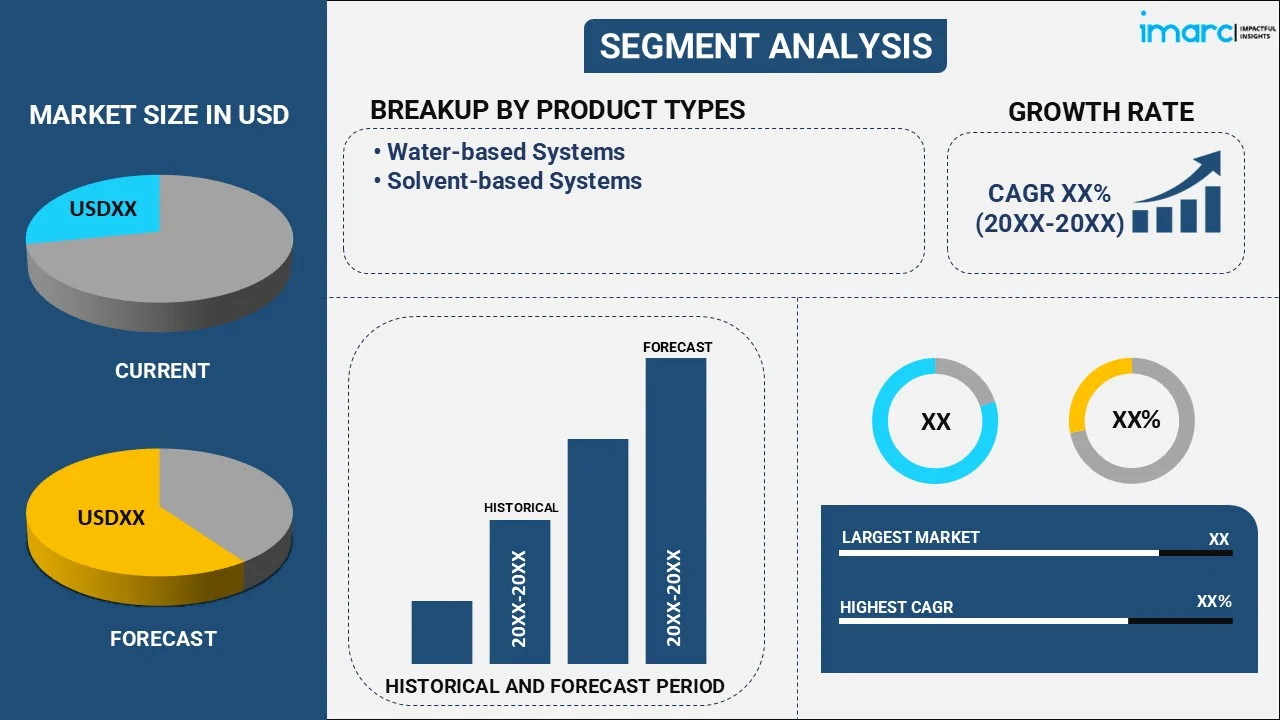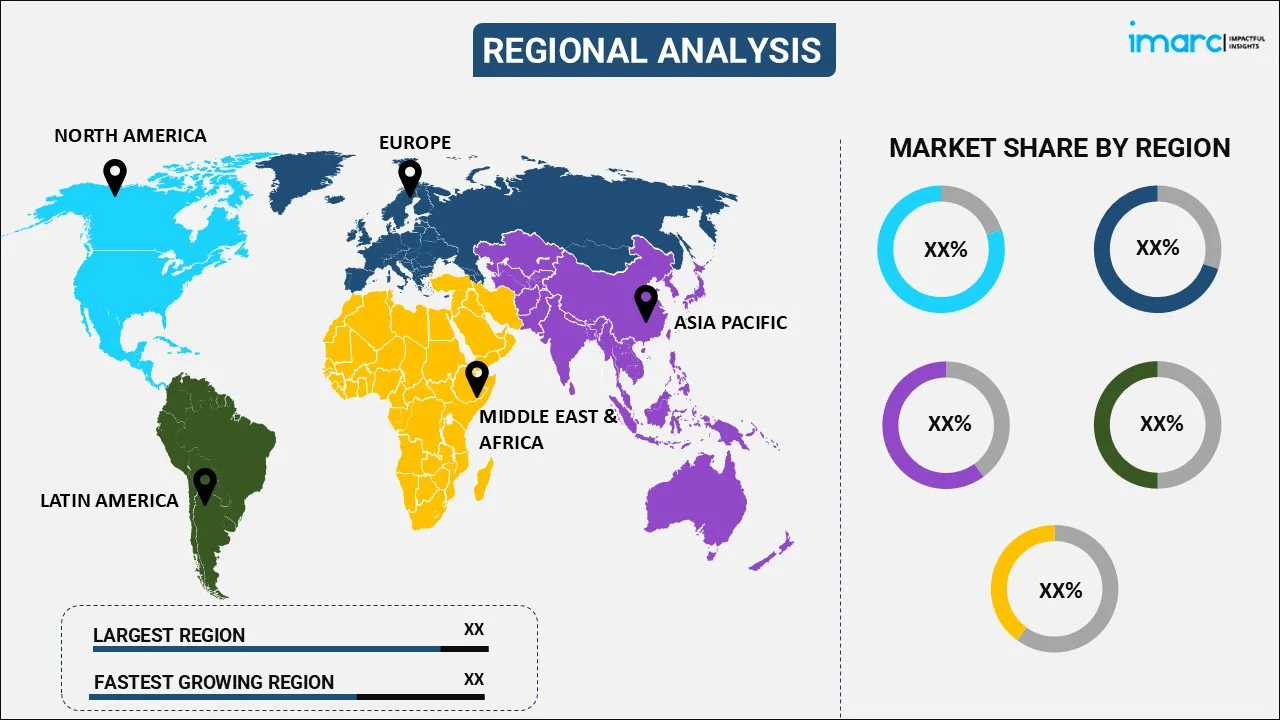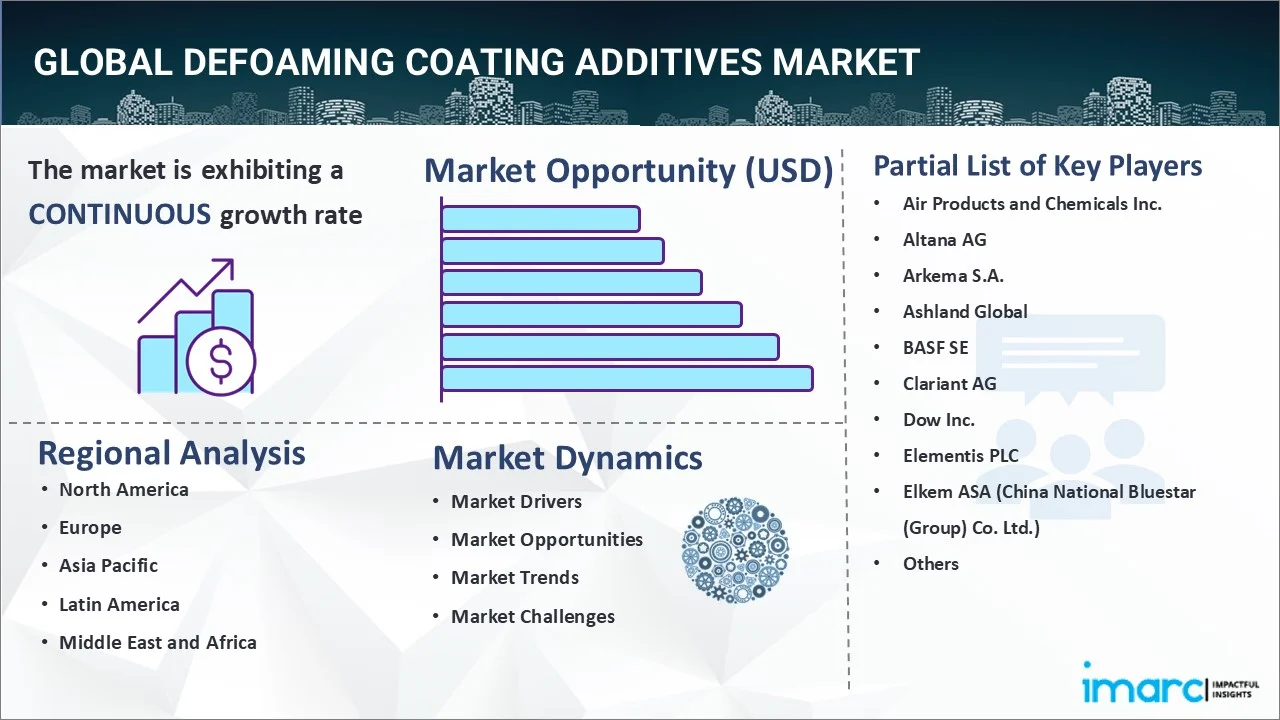
Defoaming Coating Additives Market Report by Product Type (Water-based Systems, Solvent-based Systems), Function (Foam Breaking, Foam Suppressing, Deaerating), End Use Industry (Building and Construction, Automotive, Wood and Furniture, and Others), and Region 2025-2033
Global Defoaming Coating Additives Market:
The global defoaming coating additives market size reached USD 1.4 Billion in 2024. Looking forward, IMARC Group expects the market to reach USD 2.2 Billion by 2033, exhibiting a growth rate (CAGR) of 5.3% during 2025-2033. The rising environmental concerns are stimulating the market growth.
|
Report Attribute
|
Key Statistics |
|---|---|
|
Base Year
|
2024 |
|
Forecast Years
|
2025-2033 |
|
Historical Years
|
2019-2024
|
| Market Size in 2024 | USD 1.4 Billion |
| Market Forecast in 2033 | USD 2.2 Billion |
| Market Growth Rate 2025-2033 | 5.3% |
Defoaming Coating Additives Market Analysis:
- Major Market Drivers: The rising use of protective coatings for corrosion resistance in the marine and aerospace industries is acting as a growth-inducing factor.
- Key Market Trends: The higher product adoption in industrial applications and the growing innovations in sustainable additive formulations are propelling the market growth.
- Competitive Landscape: Some of the major market companies include Air Products and Chemicals Inc., Altana AG, Arkema S.A., Ashland Global, BASF SE, Clariant AG, Dow Inc., Elementis PLC, Elkem ASA (China National Bluestar (Group) Co. Ltd.), Evonik Industries AG, Kemira Oyj, Momentive Performance Materials Inc., Solvay S.A., and Wacker Chemie AG., among many others.
- Geographical Trends: Asia-Pacific dominates the market due to rapid industrialization, the growing automotive and construction sectors, and the increasing demand for efficient as well as sustainable coatings across various applications.
- Challenges and Opportunities: The reduced effectiveness in low-shear environments is hindering the market. However, developing advanced formulations tailored for specific application conditions will continue to strengthen the market growth in the projected years.
Defoaming Coating Additives Market Trends:
Rising Adoption of Low-VOC Defoamers
The adoption of low-VOC defoamers is increasing in the market due to the growing environmental concerns and regulatory pressures. These defoamers minimize volatile organic compound emissions, thereby improving air quality and aligning with sustainability goals, while still effectively preventing foam in various coatings applications. For example, in April 2024, Evonik introduced TEGO Foamex 16 and TEGO Foamex 11, siloxane-based defoamers for waterborne coatings featuring low VOC and bio-based content. They aid in enhancing sustainability and performance.
Regulatory Standards Driving Innovation and Compliance
Regulatory standards are driving innovation in the defoaming coating additives market share by requiring safer, more effective formulations that meet strict environmental and safety criteria. Manufacturers are developing advanced defoamers that not only control foam but also comply with regulations, promoting sustainability and reducing harmful chemical usage. For instance, in June 2024, Hermeta introduced the Hermcol G8025 defoamer, which emerged as a key innovation in the market. It assists in enhancing foam control in acrylics and polyurethanes, improving operational efficiency, meeting regulatory standards, etc., driving its widespread adoption across various industries.
Expansion of Solvent-free Coating Applications
The shift towards solvent-free coatings is expanding due to health and environmental benefits. This trend increases demand for defoaming additives specifically designed for these coatings, ensuring effective foam control without solvents. These additives are essential for achieving smooth finishes in eco-friendly, solvent-free formulations across various industries. For example, in April 2024, BYK hosted a webinar on "foam-free floor coatings" and unveiled advanced defoamers specifically designed for solvent-free and solvent-borne floor coatings. The event highlighted the latest solutions to manage foam issues.
Global Defoaming Coating Additives Industry Segmentation:
IMARC Group provides an analysis of the key trends in each segment of the global defoaming coating additives market forecast at the global, regional, and country levels from 2025-2033. Our report has categorized the market based on product type, function, and end use industry.
Breakup by Product Type:

- Water-based Systems
- Silicone
- Emulsion
- Polymer
- Powder
- Others
- Solvent-based Systems
- Polymer
- Silicone
Water-based systems, including silicone, dominate the market
The report has provided a detailed breakup and analysis of the market based on the product type. This includes water-based systems (silicone, emulsion, polymer, powder, and others) and solvent-based systems (polymer and silicone). According to the report, water-based systems, including silicone, represented the largest market segmentation.
The rising demand for efficient and eco-friendly solutions in numerous industries is propelling the market. They can minimize surface tension and prevent the formation of foam during the application of coatings. For example, BASF has been at the forefront of developing innovative water-based and silicone-based defoamers.
Breakup by Function:
- Foam Breaking
- Foam Suppressing
- Deaerating
The report has provided a detailed breakup and analysis of the market based on the function. This includes foam breaking, foam suppressing, and deaerating.
Defoaming coating additives are used to break down the foam, suppress its formation, and remove entrapped air. They ensure uniform coating application by preventing defects caused by foam and air bubbles, thereby enhancing the overall quality and appearance of the coated surface. Foam suppressing additives work preventatively by inhibiting foam formation throughout the application and curing process, ensuring a smooth and defect-free finish.
Breakup by End Use Industry:
- Building and Construction
- Automotive
- Wood and Furniture
- Others
Automotive exhibits a clear dominance in the market
The report has provided a detailed breakup and analysis of the market based on the end use industry. This includes building and construction, automotive, wood and furniture, and others. According to the report, automotive represented the largest market segmentation.
Automotive applications dominate the market due to the need for smooth, blemish-free finishes on vehicles. Additionally, additives prevent foam formation during the painting process, ensuring high-quality coatings. For example, Evonik introduced silicone-based defoaming additives that enhance the finish quality and durability of the coatings.
Breakup by Region:

- North America
- United States
- Canada
- Asia-Pacific
- China
- Japan
- India
- South Korea
- Australia
- Indonesia
- Others
- Europe
- Germany
- France
- United Kingdom
- Italy
- Spain
- Russia
- Others
- Latin America
- Brazil
- Mexico
- Others
- Middle East and Africa
Asia-Pacific dominates the market outlook
The report has also provided a comprehensive analysis of all the major regional markets, which include North America (the United States and Canada); Asia Pacific (China, Japan, India, South Korea, Australia, Indonesia, and others); Europe (Germany, France, the United Kingdom, Italy, Spain, Russia, and others); Latin America (Brazil, Mexico, and others); and the Middle East and Africa. According to the report, Asia-Pacific accounted for the largest market share.
Asia-Pacific dominates the market due to its booming construction and automotive sectors. Countries like China and India are experiencing rapid urbanization and industrialization, leading to increased demand for paints and coatings that utilize defoaming additives to improve application and finish. For instance, China's extensive infrastructure projects and growing automotive production require high-quality coatings that prevent foam formation, which is driving the need for defoaming additives. In addition to this, Japan's advanced technology in manufacturing also supports the growth of this market in the region.
Competitive Landscape:
The market research report has provided a comprehensive analysis of the competitive landscape. Detailed profiles of all major market companies have also been provided. Some of the key players in the market include:
- Air Products and Chemicals Inc.
- Altana AG
- Arkema S.A.
- Ashland Global
- BASF SE
- Clariant AG
- Dow Inc.
- Elementis PLC
- Elkem ASA (China National Bluestar (Group) Co. Ltd.)
- Evonik Industries AG
- Kemira Oyj
- Momentive Performance Materials Inc.
- Solvay S.A.
- Wacker Chemie AG
(Please note that this is only a partial list of the key players, and the complete list is provided in the report.)
Defoaming Coating Additives Market Recent Developments:
- June 2024: Hermeta introduced the Hermcol G8025 defoamer, which assists in enhancing foam control in acrylics and polyurethanes, improving operational efficiency, meeting regulatory standards, etc.
- April 2024: Evonik developed TEGO Foamex 16 and TEGO Foamex 11, siloxane-based defoaming coatings additives featuring low VOC and bio-based content. They aid in enhancing sustainability and performance.
- April 2024: BYK hosted a webinar on "foam-free floor coatings" and unveiled advanced defoamers specifically designed for solvent-free and solvent-borne floor coatings. The event highlighted the latest solutions to manage foam issues.
Defoaming Coating Additives Market Report Scope:
| Report Features | Details |
|---|---|
| Base Year of the Analysis | 2024 |
| Historical Period | 2019-2024 |
| Forecast Period | 2025-2033 |
| Units | Billion USD |
|
Scope of the Report |
Exploration of Historical Trends and Market Outlook, Industry Catalysts and Challenges, Segment-Wise Historical and Predictive Market Assessment:
|
| Product Types Covered |
|
| Functions Covered | Foam Breaking, Foam Suppressing, Deaerating |
| End Use Industries Covered | Building and Construction, Automotive, Wood and Furniture, Others |
| Regions Covered | Asia Pacific, Europe, North America, Latin America, Middle East and Africa |
| Countries Covered | United States, Canada, Germany, France, United Kingdom, Italy, Spain, Russia, China, Japan, India, South Korea, Australia, Indonesia, Brazil, Mexico |
| Companies Covered | Air Products and Chemicals Inc., Altana AG, Arkema S.A., Ashland Global, BASF SE, Clariant AG, Dow Inc., Elementis PLC, Elkem ASA (China National Bluestar (Group) Co. Ltd.), Evonik Industries AG, Kemira Oyj, Momentive Performance Materials Inc., Solvay S.A., Wacker Chemie AG., etc. |
| Customization Scope | 10% Free Customization |
| Post-Sale Analyst Support | 10-12 Weeks |
| Delivery Format | PDF and Excel through Email (We can also provide the editable version of the report in PPT/Word format on special request) |
Key Benefits for Stakeholders:
- IMARC’s industry report offers a comprehensive quantitative analysis of various market segments, historical and current market trends, market forecasts, and dynamics of the defoaming coating additives market from 2019-2033.
- The research report provides the latest information on the market drivers, challenges, and opportunities in the global defoaming coating additives market.
- The study maps the leading, as well as the fastest-growing, regional markets. It further enables stakeholders to identify the key country-level markets within each region.
- Porter's five forces analysis assists stakeholders in assessing the impact of new entrants, competitive rivalry, supplier power, buyer power, and the threat of substitution. It helps stakeholders to analyze the level of competition within the defoaming coating additives industry and its attractiveness.
- The competitive landscape allows stakeholders to understand their competitive environment and provides insight into the current positions of key players in the market.
Key Questions Answered in This Report
We expect the global defoaming coating additives market to exhibit a CAGR of 5.3% during 2025-2033.
The rising demand for automobiles and the increasing requirement for architectural coatings are primarily driving the global defoaming coating additives market.
The sudden outbreak of the COVID-19 pandemic had led to the implementation of stringent lockdown regulations across several nations resulting in the temporary closure of numerous end-use industries for defoaming coating additives.
Based on the product type, the global defoaming coating additives market has been categorized into water-based systems and solvent-based systems. Currently, water-based systems, including silicone, account for the majority of the total market share.
Based on the end use industry, the global defoaming coating additives market can be bifurcated into building and construction, automotive, wood and furniture, and others. Among these, the automotive industry exhibits a clear dominance in the market.
On a regional level, the market has been classified into North America, Asia-Pacific, Europe, Latin America, and Middle East and Africa, where Asia-Pacific currently dominates the global market.
Some of the major players in the global defoaming coating additives market include Air Products and Chemicals Inc., Altana AG, Arkema S.A., Ashland Global, BASF SE, Clariant AG, Dow Inc., Elementis PLC, Elkem ASA (China National Bluestar (Group) Co. Ltd.), Evonik Industries AG, Kemira Oyj, Momentive Performance Materials Inc., Solvay S.A., and Wacker Chemie AG.
Need more help?
- Speak to our experienced analysts for insights on the current market scenarios.
- Include additional segments and countries to customize the report as per your requirement.
- Gain an unparalleled competitive advantage in your domain by understanding how to utilize the report and positively impacting your operations and revenue.
- For further assistance, please connect with our analysts.

 Request Customization
Request Customization
 Speak to an Analyst
Speak to an Analyst
 Request Brochure
Request Brochure
 Inquire Before Buying
Inquire Before Buying




.webp)




.webp)












